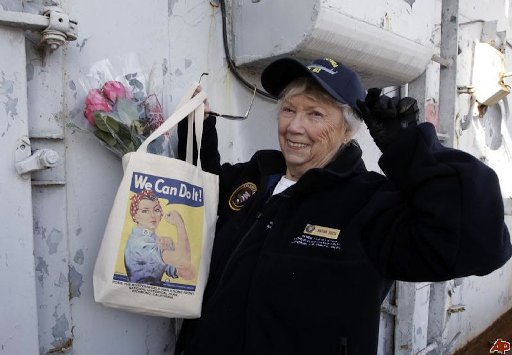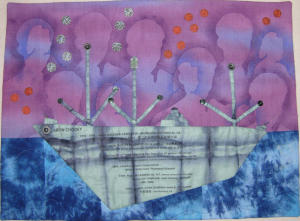| |
Bay Area quilt show stitches WWII Home Front history
By Kathryn Loosli Pritchett
Correspondent
Posted: 03/13/2014 12:00:00 PM PDT1 Comment

Former World War II Home Front worker Marian McKey Sousa, who drafted blueprints at the Richmond Shipyards, smiles while aboard the USS Iowa in Richmond during a ceremony commemorating the 70th anniversary of the Pearl Harbor attack on Dec. 11, 2011. Paul Sakuma/AP
During World War II, the Richmond Shipyards were places where women developed new skills and contributed to the war effort on the home front. Their stories and others from that period are told in a quilt show being presented next weekend in a former Ford plant on the Marina Bay, where jeeps and tanks were built.
At Craneway Pavilion, "Voices in Cloth 2014" will feature more than 200 quilts and garments from Northern California quilters, including a special exhibit of 30 quilts that tell stories about the home front.
Rosemary Corbin, former mayor of Richmond and one of the co-chairs for the show, says the home front theme for the special exhibit seemed appropriate, since the Craneway is part of the Rosie the Riveter World War II Home Front National Historical Park. Its visitor center is right next door to the pavilion.

Jeanie Low's A Salute to the Richmond Shipyard Workers: Leon Chooey is part of the "Voices in Cloth 2014, Extraordinary Quilts by the Bay" exhibit. (World WarII Home Front Quilts Project)
"Many quilters in the area have memories of their families or friends working in the shipyards or being affected in other ways by the war here at home," says Corbin, a docent at the center.
"The home front period has tremendous significance, because during that time, the workforce was integrated, women were brought into nontraditional jobs, the child care movement began, managed health care got its start, and the civil rights movement began," she says.
Organizers from the show's sponsor, the East Bay Heritage Quilters guild, issued a challenge to quilters throughout the West to tell the stories of civilian wartime life in their quilts
"Though I know quite a bit about the period, I learned a lot through these quilts," Corbin says. "Quilters did a lot of research and shared family stories that aren't found in the history books."
San Francisco quilt maker Jeanie Low created a quilt about her Chinese immigrant father, Leon Chooey, who worked as a welder building Liberty and Victory ships in Richmond.
"My dad always spoke Chinese to us at home and never talked about his time working at the shipyard. So I never realized he understood English until after he died. I found records that showed he had to write out simple facts in English to work at the shipyard," Low says. She used to play with ration tokens and steel pennies from that time around the house, she adds, but didn't realize what they were.
After reading the quilt-challenge rules, Low says, she decided to place an appliquéd image of a Liberty ship on a hand-painted background, along with stenciled silhouettes of male and female workers.
"I dyed the background fabric sunset colors, since the ships would set off at sunset to travel under the cover of darkness, and embellished the quilt with ration tokens, steel pennies and metal buttons that say 'military equipment' in French on them," Low. says. She used only materials already in her quilting stash. "I named the ship the Leon Chooey, because I found out that the Liberty ships were named for everyday people."
Marie Strait, president of the board of directors for the San Jose Museum of Quilts and Textiles and a juror for this show, selected Low's quilt for a Juror's Choice award. She says the variety of surface design techniques, subtle silhouettes and embellishment really caught her eye.
Strait has seen a growing number quilt challenges, both nationally and internationally, over the past three or four years. "These tend to be smaller quilts with a story to tell -- say, commemorating the founding of Grand Central Station," she says. "Many quilters (have) produced all the bed quilts we'll ever use, but we still ... want to keep doing what we love, just on a smaller scale."
All of the quilts submitted for the show, Strait says, had enough technical merit to be included. They're especially interesting, she adds, because they present a local perspective on history happening in our backyards.
"Quiltmakers -- both now and then -- are primarily women, and women's stories are a significant part of the home front movement," she says.
Other quilts in the exhibit depict the sending of magazines, letters and other morale boosters to the front lines. Some depict the Women's Baseball League, others the devastating effects of Japanese internment camps. Several focus on the "Rosies" -- the women who stepped up to build ships.
El Sobrante's Marian McKey Sousa, who also works at the center, is one of them. Sousa, 88, learned about the quilt challenge when an organizer came in to post a flyer. Though Sousa never had quilted before, she decided to use needle and thread to depict a blueprint of a Liberty ship -- something she drafted in the Richmond Shipyards during the war.
"At the time, I had a high school teacher who recommended I take a six-week drafting class at UC Berkeley, and that's where I learned to draw blueprints," Sousa says. "We produced 740 ships in less than four years. ... No other shipyard could equal it."
Sousa's two sisters were welders, and her mother joined the painters union. "Mom would do the prep work ahead of the painters," Sousa says. "I remember her wrapping her legs in Ace bandages to keep warm and that her hands were pretty awful looking in those years."
Sousa suffers from arthritis in her hands, and she struggles with cataracts. She says making the quilt was a challenge, but she still wanted to commemorate that chapter of her life.
"Everyone was so patriotic; there was a lot of spirit and can-do attitude," she says. "We were the workforce when the guys went off to war. We were needed."
Kathryn Loosli Pritchett writes about design at www.thingselemental.com. Contact her there or at features@bayareanewsgroup.com.
Voices in Cloth
Presented by the East Bay Heritage Quilters
When: 10 a.m.-5 p.m. March 22, 10 a.m.-4 p.m. March 23
Where: Craneway Pavilion, 1414 Harbor Way South, Richmond
Admission: $12, those
12 and younger get
in free; www.ebhq.org/
quilt-shows/vic2014/
vic2014ticket
|
|

